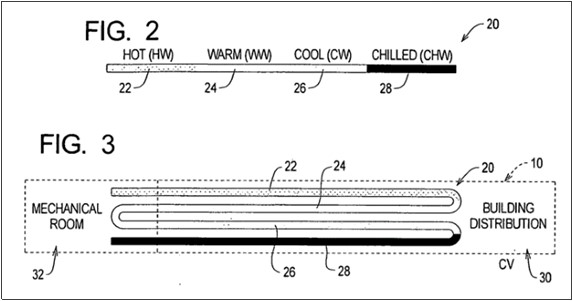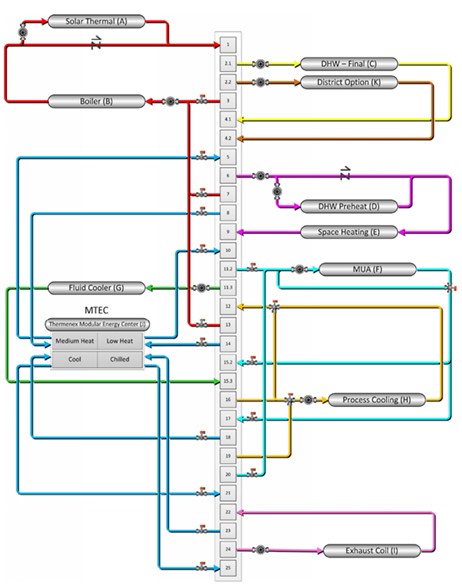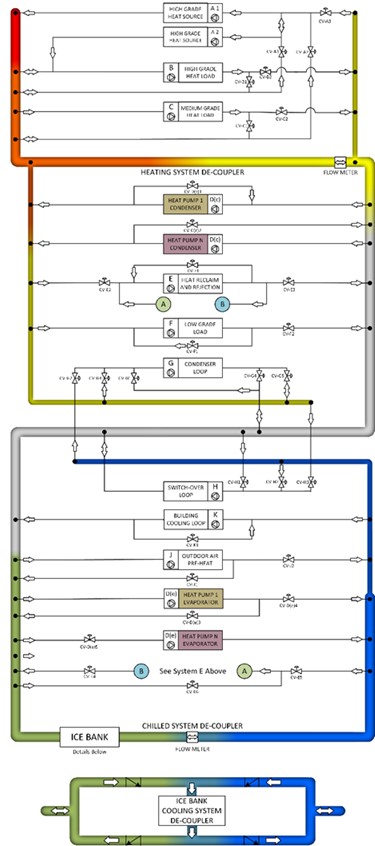The TGH concept was developed over a15 year period by a design-build mechanical contractor challenging the HVAC status quo. Our path was the relentless pursuit of thermal energy efficiency based on first principles of science with the objective of lowering cost, increasing performance, reducing carbon emissions, and simplifying operations of building mechanical systems. This is our story.
2008
Originally called a ‘Thermenex System’, the TGH began as an idea developed by Jeff Weston owner of IMEC Mechanical. The idea: All building thermal energy systems, heating, cooling, heat rejection, heat collection, integrated and managed with one pipe.
Thermenex System Version 1:

Two Version 1 systems were installed:
Langara College – Building C and Student’s Union Building
City of Coquitlam – Poirier Sports and Leisure Complex
It looks simple, but the controls were super complex. Based on lessons learned, the concept changed.
Thermenex System Version 2:

The second version of the TGH, still called a ‘Thermenex System’, looked more complex but was ‘easier’ to control with improved performance.
Multiple iterations of the second version were installed over a 10 year period in BC and Alberta with constant improvements based on lessons learned from earlier projects.
- University of British Columbia – Earth Sciences Building
- University of British Columbia – Djavid Mowafaghian Centre for Brain Health
- University of British Columbia – Wesbrook Community Centre
- University of British Columbia – Brimacombe Building and Quantum Matter Institute
- University of British Columbia – Life Building
- University of British Columbia – Undergraduate Life Sciences Teaching Laboratories
- Langara College – Science and Technology Building
- Langara College – Library
- City of Coquitlam – Municipal District Energy System, 4 buildings
- City of Coquitlam – Coquitlam Centre Aquatic Complex
- Vancouver Island Health Authority – Oceanside Health Centre
- Town of Sylvan Lake – Nexsource Centre
- Town of Cochrane – Spray Lake Sawmills Family Sports Centre
- City of Richmond – City Hall Annex
- Wall Financial – Shannon Wall Centre, 11 building District Energy Centre
- University of Fraser Valley – Student Union Building
2012-2019
UBC Properties Trust, the group in charge of new project development, were happy with the ‘Thermenex System’. It met the sustainability requirements of UBC for the lowest capital cost. However, UBC Building Operations, who were managing two of the ‘Thermenex Systems’ on Campus were not happy. For clarity, they told us they weren’t happy with any of their inherently more complex high-performance buildings. Their operators struggled to understand them as they are very different from simple boilers and chillers. UBCBO made it clear the system was too complex and they did not support future ‘Thermenex Systems’ on campus. We are grateful for their complaints, they pushed us to find a way to make the concept simpler.
2018
The team at Thermenex set out to simplify the control sequence to make it easier for operators to understand. We failed. Getting the performance our clients desired, with this version of the concept, required complex control logic. Something else had to change.
We went back to the drawing board with all our lessons learned, Searching for something that would still get the performance but be simpler to understand and operate.
2019
Success. With another innovative piping arrangement we call ‘Single Primary – Dual Secondary’, currently patent pending, the TGH was born. This arrangement automatically gets high-performance with fewer control valves and a much simpler control sequence. And, it could be standardized. Rather than multiple versions of the ’Thermenex System’ logic, which all varied based on which systems the engineer chose to connect, all TGHs now use the same simple control logic. Once an operator is trained on one TGH, they understand them all.
Aside: Most, if not all, high-performance buildings are more complex with one-off control sequences. Many of them fail to live up to performance expectations. Thermenex is a single source responsible for making sure every TGH performs.
TGH:

2019-2020
Thermenex decided to regroup and focus on product development. The control sequence was written in great detail, then vetted and peer reviewed by Taylor Engineering, the foremost consultant in standardizing HVAC control logic.
Prior to inventing the TGH, the Thermenex System was being evaluated by the Health Authorities as a potential technology to help them reach their low carbon goals. Thermenex decided to focus on healthcare facilities due to the availability of low carbon funding and the experience of their Energy and Environmental Sustainability Team, EES. ‘Thermenex Systems’ were already approved and proceeding when Thermenex integrated the TGH innovation.
First TGH:
St. Paul’s Hospital
Based on the success and performance of St. Paul’s, the following projects are underway.
In Commissioning:
Providence Health Care – – Brock Fahrni Pavilion
BC Children’s and Women’s Hospitals – 1982 Building
Under Design/Construction:
- Centre for Molecular Medicine and Therapeutics.
- BC Cancer Research Centre
- Mount St, Joseph’s Hospital
- St. Vincent’s Hospital Langara
- Holy Family Hospital
Multiple more projects are in the feasibility and planning stages.
References:
Langara College – Dwayne Doornbosch
Director of Facilities
UBC Properties Trust – Craig Shirra
Development Manager
Providence Health Care EES Team – Alex Hutton
Energy Manger
St. Paul’s Hospital – Bobbie Bees
Chief Engineer
AME Group, Mechanical Consultant- Zlatko Puljic, Mike Reimer
City of Coquitlam – Kevan Cornes
Manager Facilities
CES Analytics, Mechanical Consultant – Bernie Nelson
Principle
Black & McDonald, Mechanical Contractor – Kyle Wisniewsky
BC Division Manager
 The Thermenex Team is committed to one thing:
The Thermenex Team is committed to one thing:
Simple, cost effective, low-carbon,
high-performance buildings
Jeff Weston (604) 250-2665 | [email protected]
